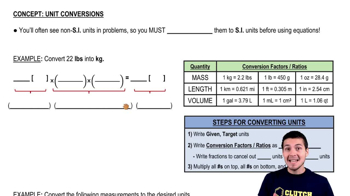Here are the essential concepts you must grasp in order to answer the question correctly.
Thermal Expansion
Thermal expansion refers to the tendency of materials to change in size or volume in response to changes in temperature. For solids, this is typically linear, meaning that as temperature increases, the length of the material increases proportionally. The degree of expansion is quantified by the coefficient of linear expansion, which varies for different materials.
Recommended video:
Coefficient of Linear Expansion
The coefficient of linear expansion is a material-specific constant that quantifies how much a unit length of a material expands per degree of temperature increase. For aluminum, this coefficient is approximately 22 x 10^-6 /°C. This value is essential for calculating the change in dimensions of the aluminum sphere when subjected to temperature variations.
Recommended video:
Conversion to Micrometers
Micrometers (μm) are a unit of length equal to one-millionth of a meter. When calculating changes in dimensions, it is often necessary to convert from meters to micrometers for precision, especially in scientific contexts. To convert meters to micrometers, one multiplies the length in meters by 1,000,000.
Recommended video:
 Verified step by step guidance
Verified step by step guidance


